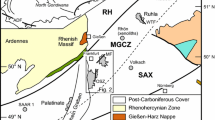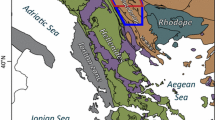Abstract
A Variscan foreland in western Poland comprises two NW-trending basement highs, which are concealed under Carboniferous through Triassic strata of the Fore-Sudetic Monocline (FSM). Both highs consist of multiply deformed quartz-sericite ± albite ± chlorite phyllites of unknown protolith age. 40Ar/39Ar laser probe dating of white micas in up to 0.5-mm-thick mica layers, which form the S2 axial-plane foliation in phyllites of the Wolsztyn–Leszno High, yielded an age of 340.1±2.6 Ma for the lower greenschists facies metamorphism and probably also for the F2 folding. This deformation was associated and followed by thrusting, which brought about the basement highs. The latter delivered clasts to overlying late Viséan–early Namurian flysch basin that was mainly sourced from the Saxothuringian Sudetes in which most of the deformation occurred between 345–335 Ma. The FSM basement may represent an independent terrane, referred to as the Wielkopolska terrane, belonging to the Armorican Terrane Assemblage.







Similar content being viewed by others
References
Ahrendt H, Clauer N, Hunziker JC, Weber K (1983) Migration of folding and metamorphism in the Rheinisches Schiefergebirge deduced from K–Ar and Rb–Sr age determinations. In: Martin H, Eder W (eds) Intracontinental fold belts. Springer, Berlin Heidelberg New York, pp 323–338
Ahrendt H, Franzke HJ, Marheine D, Schwab M, Wemmer K (1996) Zum Alter der Metamorphose in der Wippraer Zone/Harz-Ergebnisse von K/Ar-Altersdatierungen an schwachmetamorphen Sedimenten. Z Geol Ges 147:39–56
Alexander ECJr, Mickelson G M, Lanphere MA (1978) MMhb-1: a new 40Ar/39Ar dating standard. In: Zartman RE (eds) Short paper, 4th International Conference on Geochronology, Cosmochronology and Isotope Geology. US Geological Survey Open File Report 78701:6–8
Dadlez R (1997) Seismic profile LT-7 (northwest Poland): geological implications. Geol Mag 134:653–659
Dalrymple GB (1989) The GLM continuous laser system for 40Ar/39Ar dating: description and performance characteristics. In: Shanks WC, Criss RE (eds) New frontiers in stable isotopic research: laser probes, ion probes and small-sample analysis. US Geol Surv Bull 1890:89–96
Dörr W, Bylina P, Żelaźniewicz A, Franke W (2002) Tournaisian late- to-post-tectonic granitoids from the Odra Fault Zone, southwestern Poland: U–Pb zircon evidence. Schrift Dt Geol Ges 21:101
Dyjaczyński K, Mamczur S, Radecki S (1997) Nowe perspektywy poszukiwań złóż gazu ziemnego w utworach wapienia cechsztyńskiego na monoklinie przedsudeckiej. Przegląd Geologiczny 45:1248–1256
Franke W, Żelaźniewicz A (2000) The eastern termination of the Variscides: terrane correlation and kinematic evolution. Geol Soc Spec Publ 179:63–85
Górecka T, Juroszek C, Karwowski L, Kłapciński J, Lorenc S, Mierzejewski M, Sachanbiński M, Ślusarczyk S (1977) Utwory skalne podłoża permu zachodniej części monokliny przedsudeckiej i perykliny Żar oraz przyległej części bloku przedsudeckiego. Prace Naukowe Instytutu Górnictwa Politechniki Wrocławskiej 22:3–92
Górski M, Gierszeska D, Król E, Urbańska H, Wilk W (2000) Interpretacja litofacjalna danych sejsmiki 3D kluczem do sukcesu w detekcji ciał rafowych w poziomie wapienia cechsztyńskiego w basenie permskim (na przykładzie rafy Kościan). Lithofacies interpretation of 3D seismic data: key to success in the Zechstein Limestone reefs detection in the Permian Basin (on example of the Kościan Reef western Poland). Przegląd Geologiczny 48:137–150
Grabowska T, Raczyńska M (1991) Structure of the Earth's crust on the Polish Lowland in the light of gravimetric modelling. Publ Inst Geophys Pol Acad Sci A-19(230):85–110
Guterch A, Grad M, Janik T, Materzok R, Luosto U, Yliniemi J, Lück E, Schulze A, Forste K (1994) Crustal structure of the transition zone between Precambrian and Variscan Europe from new seismic data along LT-7 profile (NW Poland and eastern Germany). CR Acad Sci Paris 319(II):1489–1496
Guterch A, Grad M, Thybo H, Keller G, POLONAISE Working Group (1999) POLONAISE'97—international seismic experiment between Precambrian and Variscan Europe in Poland. Tectonophysics 314:101–121
Hartley AJ, Otava J (2001) Sediment provenance and dispersal in a deep marine foreland basin: the Lower Carboniferous Culm Basin, Czech Republic. J Geol Soc Lond 158:137–150
Haydukiewicz J, Muszer J, Kłapciński J (1999) Dokumentacja paleontologiczna osadów podpermskich w rejonie Zbąszynia (monoklina przedsudecka). In: Muszer A (ed) Wybrane zagadnienia stratygrafii, tektoniki i okruszcowania Dolnego Śląska (in Polish). ING Uwr Wrocław, pp 1-17
Jensen SL, Janik T, Thybo S, POLONAISE Working Group (1999) Seismic structure of the Palaeozoic Platform along POLONAISE'97 profile P1 in northwestern Poland. Tectonophysics 314:123–143
Kłapciński J, Lorenc S (1984) Osady karbonu na południe od Poznania. Carboniferous sediments S of Poznań. Acta Universitatis Wratislaviensis. Prace Geol-Mineral 9:19–33
Klügel T, Ahrendt H, Oncken O, Käfer N, Schäfer F, Weiss B (1994) Alter und Herkunft der Sedimente und des Detritus der nördlichen Phyllit-Zone (Taunussüdrand). Z Dt Geol Ges 145:172–191
Kossmat F (1927) Gliederung des varistischen Gebirgsbaues. Abhandlungen des Sächsischen Geologischen Landesamtes, Leipzig 1:1–39
Królikowski C, Wybraniec S (1996) Gravity and magnetic maps of Poland historical background and modern presentation. Publ Inst Geophys Pol Acad Sci M-18(273):87–89
Krzemiński L (1996) Geochemia piaskowców karbonu w podłożu monokliny przedsudeckiej: materiał źródłowy i implikacje paleotektoniczne. Polskie Towarzystwo Mineral Prace Specjalne 8:66–68
Marheine D (1997) Zeitmarken im variszischen Kollisionsbereich des Rhenoherzynikums-Saxothuringikums zwischen Harz und Sächsischem Granulitmassiv Ergebnisse von K/Ar-Altersbestimmungen. Göttinger Arb Geol Paläont 75:1–97
Marheine D, Kachlik, V., Maluski H, Patočka F, Żelaźniewicz A (2002) The Ar–Ar ages from the West Sudetes (NE Bohemian Massif): constraints on the Variscan polyphase tectonothermal development. In: Winchester JA, Pharaoh TC, Verniers J (eds) Palaeozoic amalgamation of Central Europe. Geol Soc Spec Publ 201:133–155
McKerrow WS, van Staal CR (2000) The Palaeozoic time scale reviewed. Geol Soc Lond Spec Publ 179:5–8
McDougall I, Harrison TM (1988) Geochronology and thermochronology by the 40Ar/39Ar method. Oxford monographs on geology and geophysics, vol 9. Oxford University Press, Oxford
Monié P, Soliva J, Brunel M, Maluski H (1994) Les cisaillements mylonitiques du granite de Millas (Pyrénées, France). Âge Crétacé 40Ar/39Ar et interprétation tectonique. Bull Soc Géol France 165:559–571
Monié P, Caby R, Arthaud MH (1997) The Neoproterozoic Brasiliano orogeny in Northeast Brazil: 40Ar/39Ar and petrostructural data from Ceara. Precambrian Res 81:241–264
Oberc J (1972) Budowa geologiczna Polski, Tektonika część 2, Sudety i obszary przyległe (in Polish). Wydawnictwa Geologiczne, Warszawa
Oberc J, Oberc-Dziedzic T (1978) Skały przedkarbońskie zachodniej części obszaru przedsudeckiego (in Polish). Przewodnik 50 Zjazdu PTG, pp 97–108
Oncken O (1997) Transformation of a magmatic arc and an orogenic root during oblique collision and its consequences for the evolution of the European Variscides (Mid-German Crystalline Rise). Int J Earth Sci 86:2–21
Oncken O, Plesch A, Weber J, Ricken W, Schrader S (2000) Passive margin detachment during arc-continent collision (central European Variscides). Geol Soc Spec Publ 179:199–216
Samson SD, Alexander EC Jr (1987) Calibration of the interlaboratory 40Ar–39Ar dating standard, MMhb-1. Chem Geol 66:27–34
Schulmann K, Gayer R (2000) A model for a continental accretionary wedge developed by oblique collision: the NE Bohemian Massif. J Geol Soc Lond 157:401–416
Steiger RH, Jäger E (1977) Subcommision on geochronology: convention on the use of decay constants in geo- and cosmochronology. Earth Planet Sci Lett 36:359–362
Tait J, Bachtadse V, Franke W, Soffel HC (1997) Geodynamic evolution of the European Variscan fold belt: palaeomagnetic and geological constraints. Geol Rundsch 86:585–598
Whitney DL, Mechum TA, Kuehner SM, Dilek YR (1996) Progressive metamorphism of pleitic rocks from protolith to granulite facies, Dutchess County, New York, USA: constraints on the timing of fluid infiltration during regional metamorphism. J Metamorph Geol 14:163–181
Wierzchowska-Kicułowa K (1984) Budowa geologiczna utworów podpermskich monokliny przedsudeckiej. Geology of the Pre-Permian series of the Fore-Sudetic Monocline—summary. Geol Sudetica 19:121–142
Żelaźniewicz A, Cwojdziński S, England RW, Zientara P (1997) Variscides in the Sudetes and the reworked Cadomian orogen: evidence from the GB-2A seismic reflection profiling in southwestern Poland. Geol Q 41:289–308
Żelichowski A (1983) Lithological associations in the Carboniferous in Poland. Przegląd Geol 6:342–350
Żelichowski A (1995) Occurrence of Carboniferous rocks and palaeotectonic conditions of sedimentation in the area of Poland-Western Pomerania and central Poland. In: Zdanowski A, Żakowa H (eds) The Carboniferous system in Poland. Prace Instytutu Geol 147:14–17
Acknowledgements
The work was performed at the ISTEEM-CNRS in the Laboratoire de Géochronologie, Université Montpellier II run by H. Maluski and P. Monié whose support is gratefully acknowledged. Thanks are due to Wolfgang Franke for his comment on the earlier version of the manuscript. The final version benefited from the reviews by Onno Oncken and Gernold Zulauf.
Author information
Authors and Affiliations
Corresponding author
Rights and permissions
About this article
Cite this article
Żelaźniewicz, A., Marheine, D. & Oberc-Dziedzic, T. A Late Tournaisian synmetamorphic folding and thrusting event in the eastern Variscan foreland: 40Ar/39Ar evidence from the phyllites of the Wolsztyn–Leszno High, western Poland. Int J Earth Sci (Geol Rundsch) 92, 185–194 (2003). https://doi.org/10.1007/s00531-002-0306-7
Received:
Accepted:
Published:
Issue Date:
DOI: https://doi.org/10.1007/s00531-002-0306-7




